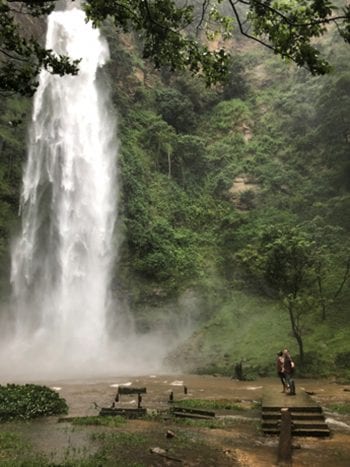Identifying solutions for enrollment, regulatory requirements, drug procurement, and improved collaboration for an international clinical trial in Hohoe Ghana
By Rachel Bick and Philip Budge
October 5, 2018
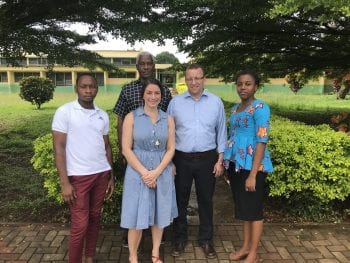
The DOLF Project recently sent two team members, Philip Budge and Rachel Bick, to visit the Nick Opoku and the DOLF Onchocerciasis research team in Hohoe, Ghana. Our goals were to meet with Ghanaian partners, observe study enrollment, work collaboratively to solve challenges related to study implementation. While in Ghana, we also met key people at partner institutions and visited the Wli Waterfall.
The study in Hohoe uses innovative ophthalmology methods including Ocular Coherence Tomography (OCT) to examine the kinetics of microfilaria clearance from the eye following a dose of ivermectin. Our September blog details how the two projects fit together: the first study (Part I) will conclude with a follow-up at 6 months that also serves as the baseline for the second study (Part II) which will test the safety and efficacy of “IDA” a triple drug combination for the treatment of onchocerciasis following that clearing dose of ivermectin.
Our visit to Hohoe coincided with enrollment of the third cohort (of fourteen cohorts
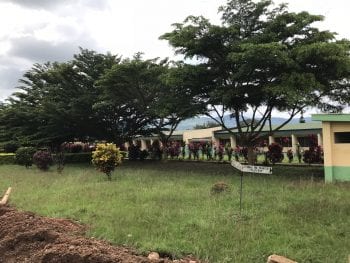
total) for Part I. Each cohort is brought from the northern area of Kpassa to the Onchocerciasis Chemotherapy Research Centre (OCRC) in Hohoe. They stay there for 9 days. On the first day, they receive visual field examinations, physical examinations, and settle into their quarters, which were renovated for this project and include a waiting area with a large TV for the participants’ comfort and entertainment. On the next day, the “eye team”, which includes an ophthalmologist, an optometrist, two technicians, and several study staff, work very hard (sometimes a full 10 hours!) to provide the necessary ocular examinations.
Study ophthalmologists developed the eye exam protocols to achieve the following goals: 1. ensure patient safety by making sure that no one with severe pre-existing eye problems enters the study, 2. document the presence or absence of onchocercal microfilariae in the eye, and 3. document any potential ocular effects of microfilarial death after treatment with ivermectin.
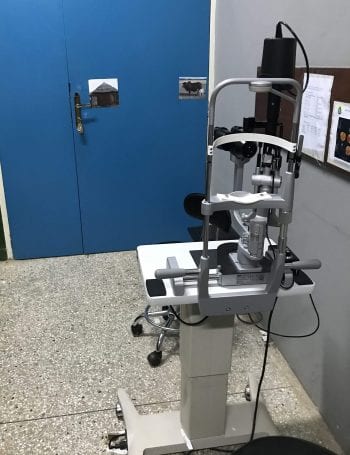
While in Hohoe, we worked with Dr. Opoku’s team to tackle some of the following. First, most participants do not speak the same language as the clinical staff making it hard for them to understand and follow instructions for each exam. Since most ocular exams depend on the ability of the patient to focus their gaze in a particular direction, this language barrier can be frustrating to both examiners and participants. To help mitigate this problem, we placed pictures of familiar objects on walls to help participants fix their gaze. We also prepared written scripts for translation into Konkomba (the participants’ language) that explain the purpose and procedure for each exam.
Another challenge in the exam room was to verify that all information gets recorded on

the correct case report form (CRF). Because multiple eye exams are taking place concurrently in a small space, the opportunity to mistakenly grab the wrong participant’s form needed to be minimized. To grease this squeaky wheel, patient barcodes, which were previously assigned at the time of treatment and then marked on each participant’s binder containing his or her CRF, will now be assigned at the time of arrival in Hohoe. The patients will now have disposable wristbands with their barcode sticker on it, which should make it much easier for study team members to verify each participant’s ID number, preserve confidentiality, and prevent any potential errors.
Other technical challenges facing the team included taking photos and videos of microfilariae at the slit lamp using an iphone. Luckily, we were able to share some iPhone tricks for focusing the camera, which improved the procedure. Now the study staff have the ability to collect high quality videos of microfilariae in the anterior chamber of the eye. Check it out!
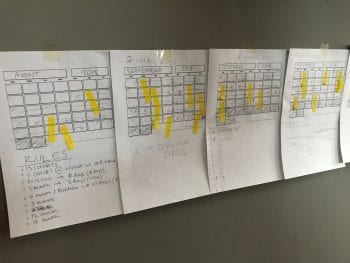
In addition to observing the study enrollment, we worked with Dr. Opoku on planning for the second trial. Here’s the math: there are 14 cohorts of 20 patients each (280 patients total) to enroll in the study. Bringing each cohort to Hohoe for enrollment takes 11 days (including travel days). Since the patient quarters cannot accommodate more than 20 patients, and since the follow-up visits from one cohort can’t overlap with enrollment of others…we had to do some creative planning to meet the protocol requirements (see figure).
With Nick Opoku’s help we were also able to meet with key partners of the project at the University of Health and Allied Sciences in Ho, including: the medical monitor for Part II, the procurement office, and the very helpful staff of the ethics review committee.

For Part II ethics review, we will need to obtain IRB approvals from review committees at Washington University in St. Louis, Case Western Reserve in Cleveland, the University of Health and Allied Sciences, the Ghana FDA and the Ghana Health Service. Personal contact with members of these committees really helps us ensure our protocols are culturally appropriate and respect local customs, while achieving important research goals.
One additional highlight of the trip was meeting with Dr. George Kyei at the Noguchi Medical Research Institute in Accra. George is a talented HIV researcher with joint faculty appointments at WashU and Noguchi, and a vital participant in Wash U’s global health partnerships, and it was great to be able to visit him in his new environment.
The last story to tell about our trip to Ghana is that of visiting the Wli Waterfall outside of Ho. We left at 5:30 in the morning to visit the falls before driving to Ho for a full day of meetings, and hiked in the rain through the woods to see it! We felt lucky to be able to squeeze this in, as it was amazing to see such natural beauty!
